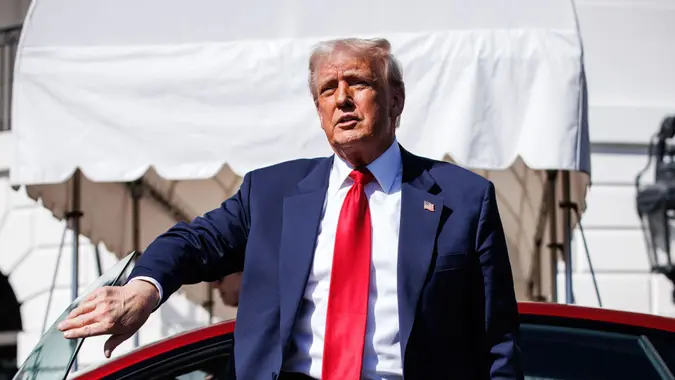Trump Just Announced ‘Liberation Day’ Tariffs and Stocks Tumbled — What Investors Need To Know

Commitment to Our Readers
GOBankingRates' editorial team is committed to bringing you unbiased reviews and information. We use data-driven methodologies to evaluate financial products and services - our reviews and ratings are not influenced by advertisers. You can read more about our editorial guidelines and our products and services review methodology.

20 Years
Helping You Live Richer

Reviewed
by Experts

Trusted by
Millions of Readers
President Donald Trump’s self-proclaimed “Liberation Day” of Apr. 2, 2025 will almost surely go down in infamy, but perhaps not how the president himself had intended. After Trump announced a massive slate of surprisingly high tariffs on nearly 200 countries across the globe, U.S. stocks nosedived to their lowest numbers since the summer of 2020, when with COVID-19 pandemic ground the U.S. economy to a near-halt.
Now, America’s trade partners are planning their own reciprocal tariffs as retaliation for Trump’s, and Wall Street is mired in uncertainty and some (such as House Minority Leader Hakeem Jeffries, as reported by CNN) are predicting a recession.
Here’s what investors need to know about the announcement of these global tariffs.
Trump’s Tariffs — What Happened?
President Trump ratcheted up his ongoing trade war, just as he promised he would, surprising very few observers. What was surprising, though, was just how far Trump escalated the situation: A baseline of 10% tariffs is to be implemented on all imports coming into America, with over 50 additional countries receiving even higher tariffs beginning on Apr. 5.
The European Union was hit with 20%, Japan with 24%, China with 34% and Vietnam a staggering 46%, per CNN. Additionally, as CNBC has reported, many were expecting 10% tariffs to be the absolute highest, worst-case-scenario tariff cap, rather than Trump’s baseline starting point.
As a result, many of the countries impacted — such as China, Japan, Mexico, South Korea and more — are expected to levy their own devastating tariffs upon America.
How Did This Impact the Stock Market?
Given that the tariffs were far more extreme than expected — bringing with them the risk of inflation, followed by a potential recession — stocks tumbled by the early evening on Wednesday, with Wedbush Securities senior analyst Dan Ives telling CNN that Trump’s announcement was “worse than the worst case scenario” that Wall Street had been bracing for.
The Dow Jones fell 3.98%, the Nasdaq Composite dropped 5.97% and the broad market index collapsed by 4.84% — the worse numbers for each since the first COVID summer of 2020. A number of multinational corporations and companies with global interests took hits, from Nike to Apple to Tesla. The stock numbers fell so drastically, and so quickly, that economists with JPMorgan noted that a recession may be unavoidable if Trump’s announced tariffs are not decreased.
What Should Investors Do Now?
As The Motley Fool has reported, a great deal of this stock market instability is rooted in the fact that there is simply no certainty as to what will happen next.
Foreign countries could negotiate with Trump and lower the tariff rates, or Trump could continue to escalate the trade war to unforeseen and increasingly risky levels. There simply isn’t a certainty as to what will happen next.
That said, The Motley Fool also cautioned that what investors should do isn’t nearly as important as what investors shouldn’t do — investors should not, under any circumstances, panic.
Panic-selling in the face of frightening uncertainty can do far more harm than good for the individual investor, and create even more instability and market depreciation than currently exists. Perhaps the safest (and only) thing to do is to wait, and observe, until a measure of certainty returns to the market.
Editor’s note on political coverage: GOBankingRates is nonpartisan and strives to cover all aspects of the economy objectively and present balanced reports on politically focused finance stories. You can find more coverage of this topic on GOBankingRates.com.
 Written by
Written by  Edited by
Edited by 

























